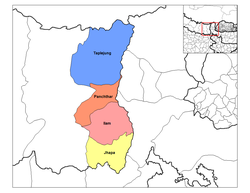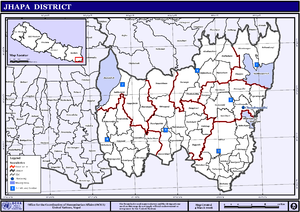| Jhapa | |
|---|---|
| — District — | |
| Country | |
| Region | Eastern (Purwanchal) |
| Zone | Mechi |
| Area | |
| - Total | 1,606 km2 (620.1 sq mi) |
| Population (2001) | |
| - Total | 688,109 |
| - Density | 428.5/km2 (1,109.7/sq mi) |
| Time zone | NPT (UTC+5:45) |
Jhapa District, a district of Mechi Zone, is one of the seventy-five districts of Nepal. The district, with Chandragadhi as its district headquarters, covers an area of 1,606 km² and has a population (2001) of 688,109.
Contents[hide] |
Location
Jhapa is the easternmost district of Nepal and lies in the fertile Terai plains. It borders Ilam district in the north, Morang district in the west, the Indian state of Bihar in the south and east, and the Indian state of West Bengal in the east.
[edit] Administration
The district is divided into 47 Village Development Committees (VDCs) and three municipalities, namely Bhadrapur in the south, Mechinagar in the east and Damak in the west. Its major centers are Chandragadhi, Bhadrapur, Birtamod, Kakarbhitta, Damak, Dhulabari, Budhabare, Surunga, Charali, Baniyani, Kechana, Patharia, Balubadi, Gherabari, Pathamari, Prithvinagar, Halddibari, Maharanijhora, Lakhanpur, Gauradaha, Topgachhi.
Village Development Committees (VDCs)
- Anarmani
- Arjundhara
- Bahundangi
- Baigundhura
- Balubadi
- Baniyani
- Budhabare
- Chakchaki
- Chandragadhi
- Charpane
- Dangibari
- Dhaijan
- Dharmpur
- Dudhe
- Duhagadhi
- Garamani
- Gauradaha
- Gauriganj
- Ghailadubba
- Gherabari
- Goldhap
- Garamuni 2
- Haldibari
- Jalthal
- Jhiljhile
- Juropani
- Jyamirgadhi
- Kechana
- Khajurgachhi
- Khudnabari
- Kohabara
- Korobari
- Kumarkhod
- Lakhanpur
- Mahabhara
- Maharanijhoda
- Maheshpur
- Mechinagar
- Panchganchi
- Pathamari
- Pathariya
- Prithivinagar
- Rajghadh
- Sanischare
- Satasidham
- Shantinagar
- Sharanamati
- Shivaganj
- Surunga
- Taganduba
- Topgachchi
Demography
Jhapa is home to many indigenous ethnic nationalities such as the Limbu, Rai, and Dhimal . Other ethnic groups such as Dhangad, Koche, Rajbanshi, Satar, Meche, Tamang, Uraon, Magar, Gurung , Gangain and many others came to Jhapa in the late 19th century, so did the Hill/mountain castes Bahun, Chhettri, and Newar.
Jhapa is diverse and rich in culture and traditions due to the influences of its different tribes. All the tribes/ethnic groups have their own languages, customs and traditions, and they celebrate their festivals every year.
Climate and Geography
Jhapa receives 250 to 300 cm of rainfall a year, and mostly during the monsoon season in the summer, and its hilly northern area receives more rainfall than the south. Its major rivers, like the Mechi River, Kankai Mai, Ratuwa, Biring, Deuniya,(Aduwa), (Bhuteni)(Dhangri), Hadiya, and Ninda,Krishne Khola, Gauriya, Ramchandre etc provide water for irrigation. Due to its alluvial soil best suited for agriculture, Jhapa has been the largest producer of rice and is therefore known as the Grain Grocery of Nepal[citation needed]. Besides cereal crops like rice and wheat, it is also one of the largest producers of jute, tea, betel nut, rubber and other cash crops.
Jhapa also has vast areas of forests, such as Deonia, Charali, Charkose Jhaadi, Hadiya, Sukhani, Jalthal, and others. Its name itself is derived from the Rajbanshi word "jhapa" meaning "canopy", which suggests that the area was a dense forest in the past. It was once such a dense and dangerous forest that it was called Kaalapaani and prisoners were sent here to die of malaria and other diseases in the jungle.
Attractions and Sites
Jhapa also has several religious and historical sites of great importance like Kankai Mai, Kichakbadh, Satasidham, Arjundhara, Chillagadh, Biratpokhar, and Krishnathumki among others. It is believed that Pandu's son Bhim had killed Kichak in Kichakbadh (near Kechana in the south border) in the time of the Mahabharata and a great festival is observed on that day every year. There is also the historical fort of Chandragadh which gave its name to Chandragadhi. Other sites too have their own religious and historical values. It is also the gateway to Darjeeling and Sikkim and the rest of north-east India from Nepal.
[edit] Development
Jhapa is one of the most developed districts of the country. Almost all the villages and towns are linked by roads. There are schools and colleges in many parts of the district. There is also an airport and a hospital in Chandragadhi. It has the highest literacy rate in the country after Kathmandu, Kaski and Chitwan districts.
Education
Jhapa has a good literacy rate of 66.93[1] percent which is highest in Nepal after the capital city Kathmandu. Lots of school like suryodaya English School,Damak, Deep Jyoti Vidya Mandir-Arjundhara,[Gyanodaya Shiksha Niketan-Dhulabari], Laxmi Higher Secondary School-Baniyani, Little Flower's English School, Bal Kalyan School-Charpane, Harikul Model Higher Secondary School, Kankai Boarding School,Karnali International Boarding School Budhabare, Amity College, Emerald Academy, etc. have been providing quality education in Jhapa. Mechi Multiple Campus under the affiliation of Tribhuwan University is the oldest government college in Jhapa. Students from neighbouring districts also come here for higher education.
Role in National Politics
It plays the main role in national politics. The Communist revolution was started from the Jhapa, which led to formation of one the most prominent party of nation CPN-UML. Many national political figures are from Jhapa such as R.K Mainali,K.P Oli, K.P Sitaula, Chakra Bastola, C.P Mainali. Recently during JanaAndolan 2063 (April Revolution) Jhapa played a significant role in the agitation against Royal takeover. Around 5 peoples were killed by the Royal Army in Bhadrapur and many more deaths weren't disclosed.
Agriculture and Industry
Jhapa is also famous for microcredit development. The Small Farmer Development Programme (SFDP) was the first rural and micro-financing program in Jhapa. The Agricultural Development Bank started this Small Farmer Development Programm in 1988. It started in a few VDCs and spread. After lifted many people out of poverty, the SFDP was handed over to the local people and the new institution was named Small Farmer Cooperative Ltd (SFCL). There are currently 13 SFCLs in Jhapa, each of which covers a single VDC.
It is one of the major area for the Production of Tea and Rice. Budhabare situated on the northern side of the Mahendra Highway is the most fertile land of Nepal. It is the one of the best market place fo r the rice. It is also popular for the bittle nuts (Supari). Several large Tea Estate are also located in Jhapa. Giri Bandhu Tea Estate, Burne tea state, Tokla Tea Estate, Sattighatta Tea Estate are the Major ones.
































No comments:
Post a Comment